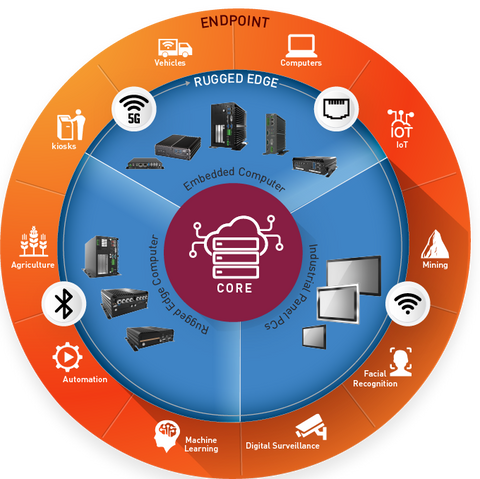In IoT, ‘faster, smarter, better’ has culminated in edge computing…a novel concept that brings technology and processing close to where IoT sensors generate data. Perfect in a stable setting like a data center. But what happens in more challenging environments that are less, um, predictable? Enter rugged edge computing, which extends the localized data processing of edge computing to serve more demanding industrial IoT (IIoT) environments. Thanks to specialized hardware from Premio (Figure 1), advanced software algorithms can go beyond the edge to deliver the intelligence required for IIoT efficiency and consolidation, advancing automation in heavy industrial applications.

Figure 1 - Premio Rugged Edge computers shift closer to data generation and endpoints for mission-critical processing, storage, and telemetry to and from the cloud
Consider applications such as high-speed automation, defect detection and prevention, and image recognition – all these work in an ecosystem where machines take on the capabilities of their human counterparts but with increased speed and accuracy. Computer vision combines vision technology and cognitive machine-learning processing power to ingest and apply images much like a human brain or a neural computing network. It trains and retrains the system with new data for greater efficiency and non-stop improvement. In these applications, faster computational power and advanced real-time graphics accelerators play a new and growing role in uncovering errors in real-time. And in severe physical settings, reliable deployment is job one for any rugged, high-performance system. Every element, from the external enclosure to internal components, must be fundamentally designed to tackle environmental issues such as harsh temperatures, intense vibration, and the presence of moisture or dirt. Extreme processing power and storage capacity are also important, and must ensure steady, round-the-clock operation in a long-life system.
These factors perfectly define the need for rugged edge computing, purpose-built systems to handle artificial intelligence and machine learning in harsh physical settings. Rugged edge strategies allow IT infrastructure to move closer to the operational level, delivering the operational intelligence and machine learning that drives real-time decision making. Intelligent machines can then work independently, freeing the human workforce to handle more strategic business operations. Costs are reduced and safety is increased, values powered by smarter, real-time data insights – and these benefits apply to a spectrum of applications such as automatic product line inspection, intelligent security surveillance, biomedical imaging, vision-guided robotics/vehicles, and so much more.
It’s all about tapping into scalable processing and graphics performance on a ruggedized hardware platform – even as systems are constrained by the rigors of their physical environment and highly sensitive to latency, bandwidth, and reliability issues. For example, Premio’s next generation rugged edge systems leverage NVMe™ (Non-Volatile Memory Express), an established data center protocol also of benefit to edge workloads.
A smart rugged edge design also features hardware-based security, capitalizing on TPM 2.0 cryptographic keys to shield digital data communications between devices from external attacks. This protocol, coupled with edge autonomy, protects sensitive data and signals to allow processing without rerouting to less secure cloud resources – a critical advantage to rugged edge computing.
At the rugged edge, the right combination of capabilities and cost must include diverse, high-speed I/O, multicore accelerators, and a graphics engine empowering deep learning and inference analysis at the network edge. Connect with the Premio engineering team to gain more insight into the rugged edge and how smart hardware strategies can enable system longevity and reliable, real-time software algorithm performance. Our team is ready to collaborate, from design to manufacturing to deployment, guiding your heavy industrial operations to real-time decision making fueled by fast, predictive analytics at or near the data source.



